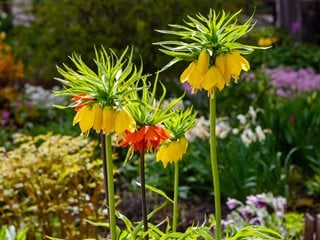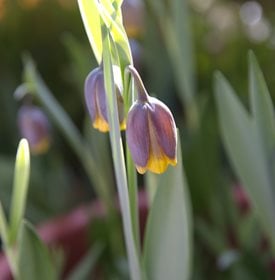A Guide to Growing Fritillaria Bulbs
Get tips for planting, caring for, and using these unique and showy spring-flowering bulbs.Many gardeners fall head over heels for Fritillaria, and it’s easy to understand their adoration. In a spring garden full of daffodils, tulips, and other conventional spring bloomers, these exotic-looking plants stand apart from the rest. From the captivating patterned blooms of the checkered lily (F. meleagris) to the stately crown imperial’s (F. imperialis) tufted tiara of bell-shaped flowers, fritillaries bring their own distinct personality to spring flowerbeds and containers.
On this page: Basics | Planting | Care | Fritillaria Varieties
On this page:
BASICS
Botanical name:
Fritillaria spp.
Zones:
4-9, but may vary depending on the species
Exposure:
Full sun to partial shade
Bloom time:
April, May
Height:
8 to 48 inches tall
Flower color:
Shades of white, yellow, orange, red, or purple, some with bicolored patterns
Foliage:
Grassy or strap-like, usually medium green or gray-green
Types:
There are more than 100 species of Fritillaria, most of them native to Europe, Asia, and the Middle East. The tallest and most attention-getting varieties include the crown imperial (F. imperialis) and the Persian lily (F. persica), both of which bear flowers on an upright stalk growing to a height of 3 feet or more. Lower-growing selections (under a foot tall) include Michael’s flower (F. michailovskyi) and checkered lily (F. meleagris), which are characterized by arching stems of dainty bell-shaped flowers.
Uses:
Woodland gardens, mixed borders, naturalizing, rock gardens, containers
HOW TO PLANT FRITILLARIA BULBS
When to plant:
Late summer or early fall. Fritillary bulbs are more perishable than most fall-planted bulbs, so they should be put in the soil soon after they are purchased.
Where to plant:
Fritillaries can be exacting in their cultivation requirements, particularly when it comes to moisture and soil conditions. Some species grow best in well-drained, sandy soil and bright sunlight while others require moisture-retentive soil and dappled shade. Check the growing requirements of each species carefully to identify those that will thrive in your garden.
Note: All parts of the crown imperial have a skunky odor that can be unpleasant at close range, so this plant is best positioned at the back of the border and away from pathways. Or place it among tulips, daffodils, and other spring bulbs to fend off rabbits, deer, squirrels, and other pests.
Soil conditions:
Soil requirements vary, but most fritillaries prefer rich, well-draining soil high in organic matter. Some species are especially vulnerable to rot caused by wet soil and will benefit from the addition of some sand to improve drainage.
Planting depth and spacing:
Plant the large bulbs of crown imperial and Persian lily about 6 to 7 inches deep and 8 to 10 inches apart. The bulbs of smaller species can go in shallower holes 3 inches deep at a spacing of 3 to 4 inches. Note that crown imperial bulbs have natural depressions on top where water can collect. Placing the bulbs sideways in their planting holes will make them less vulnerable to rotting.
Propagation:
Divide the bulbs after the foliage has died back to the ground in midsummer by loosening the soil and carefully separating the smaller bulbs from the parent. Store the divided bulbs in a cool, dark area until you are ready to plant them in the fall.
FRITILLARIA CARE
Watering:
Water well in the fall after planting and in spring when plants are actively growing (about an inch of water per week). Most fritillaries like dry conditions when they are dormant.
Fertilizing:
Add bulb fertilizer to the soil when planting, and apply a low-nitrogen fertilizer when the leaves begin to emerge in early spring.
Cutting back:
After blooming has finished for the season, you can remove the spent flowers, but don’t cut your plants back to the ground until the foliage turns completely yellow. While the leaves are still green they will continue to gather energy from sunlight to be stored in the bulb for next year's flowers.
Pests and problems:
Fritillaries are relatively trouble-free, but because they are members of the lily family (Liliaceae), they’re vulnerable to damage by the scarlet lily beetle, which will feast on the foliage and flowers. The best methods of eradication include removing the beetles by hand as soon as you spot them or by applying a botanical insecticide, such as neem oil. The foliage may also be susceptible to rust and leaf spot.
FRITILLARIA VARIETIES
RELATED:
Top 20 Spring-Blooming Bulbs
The Best Summer Bulbs to Grow












